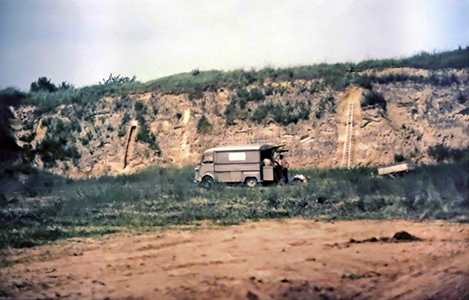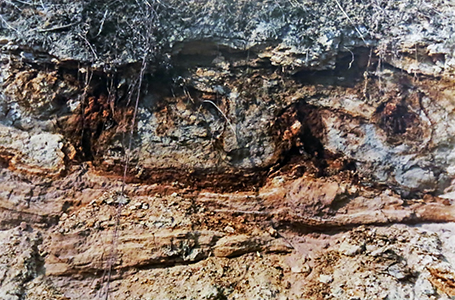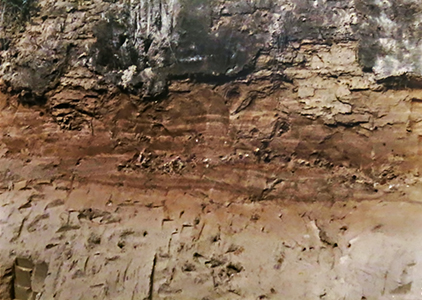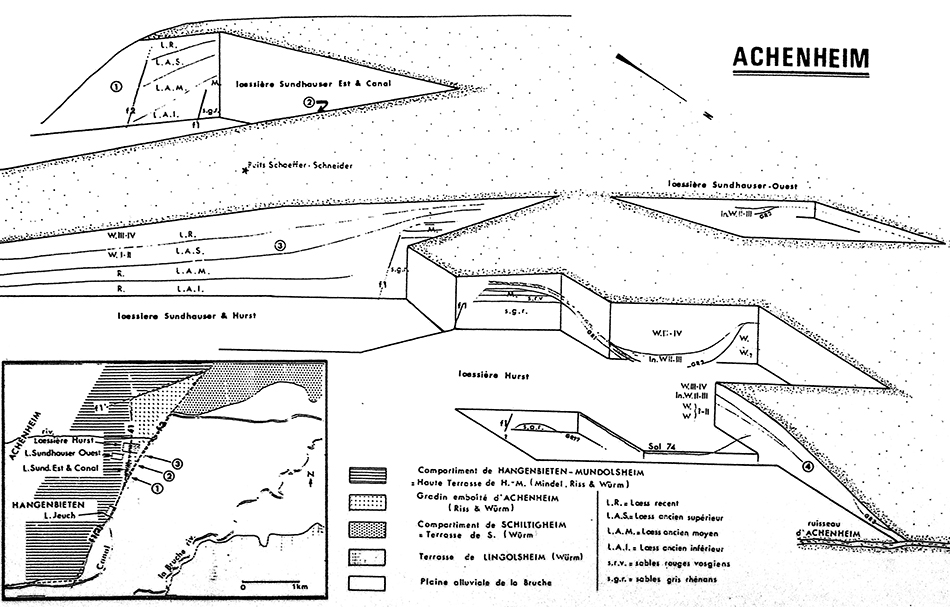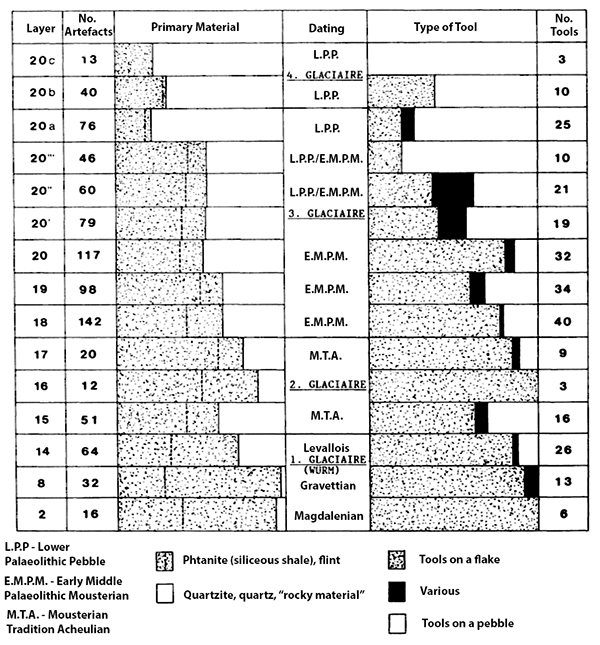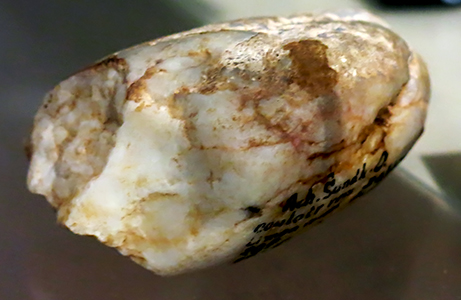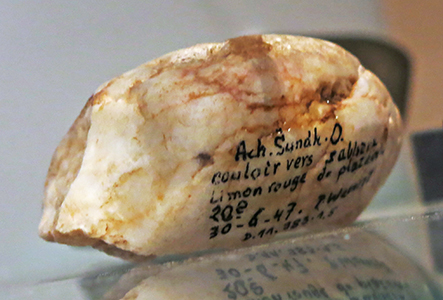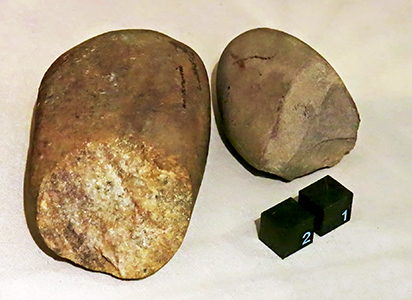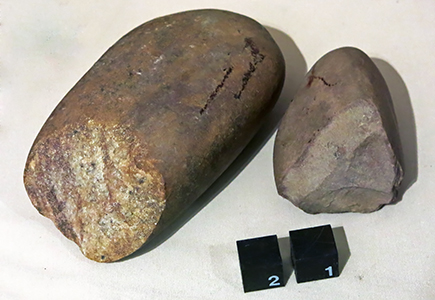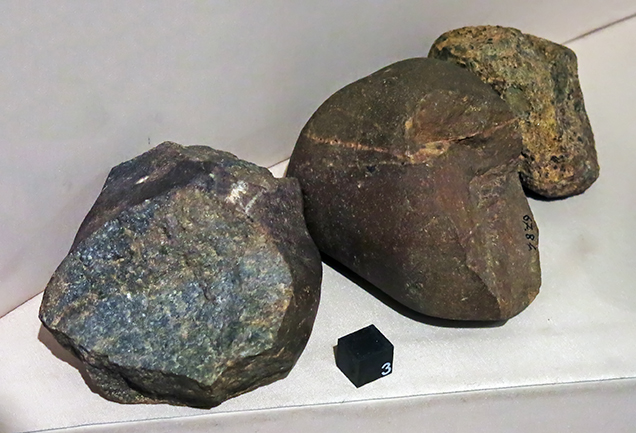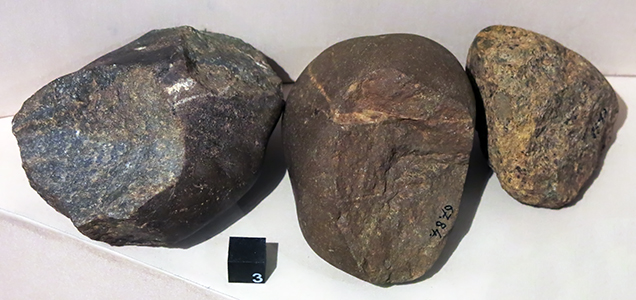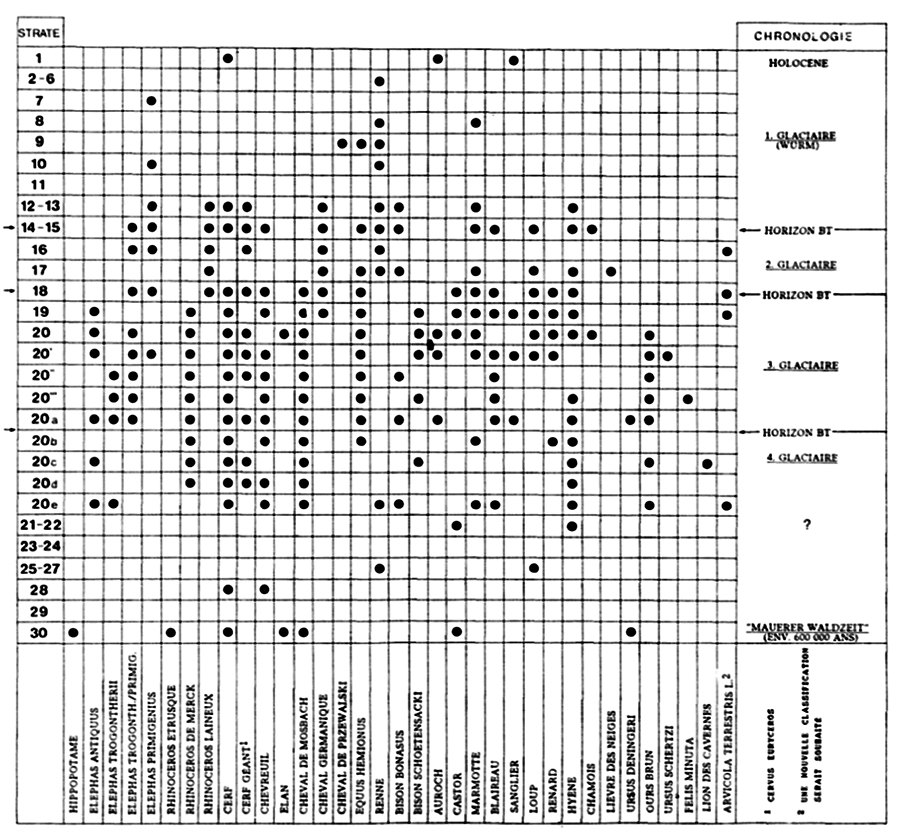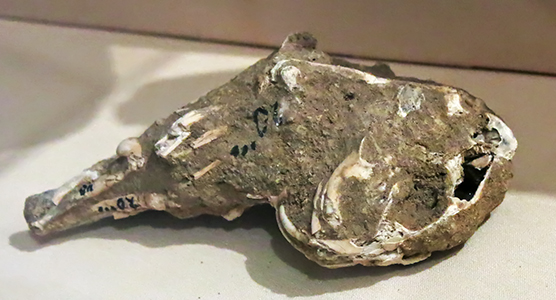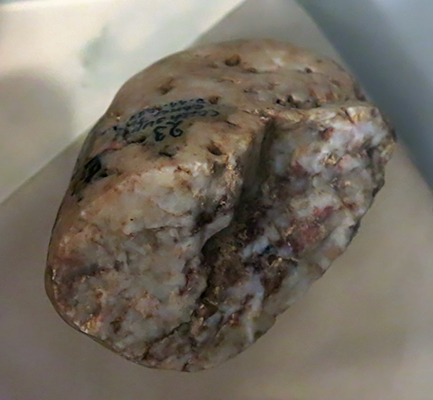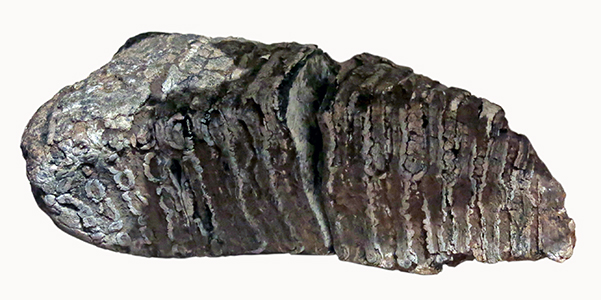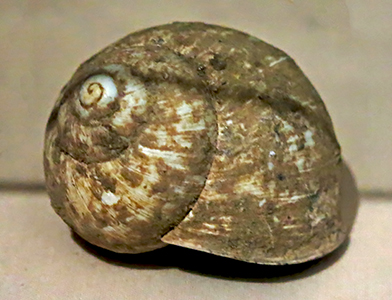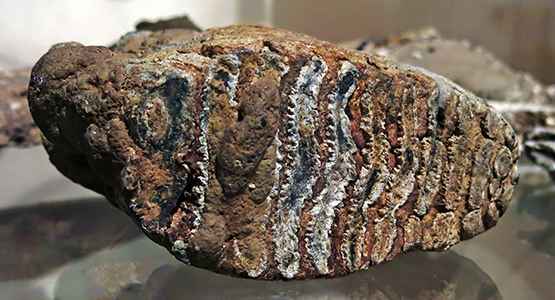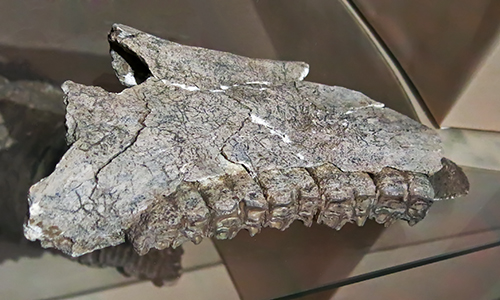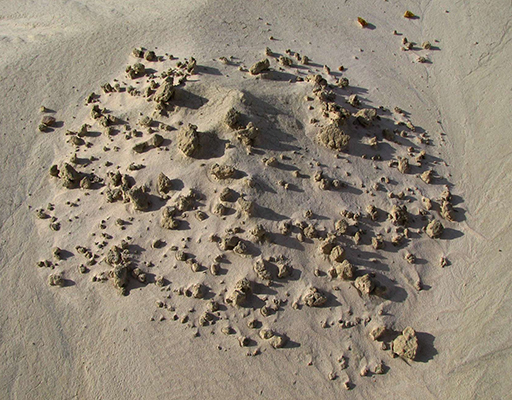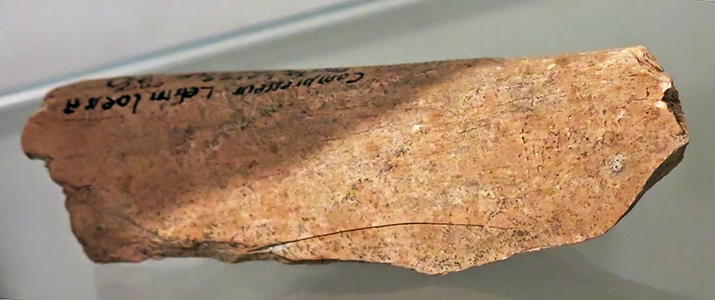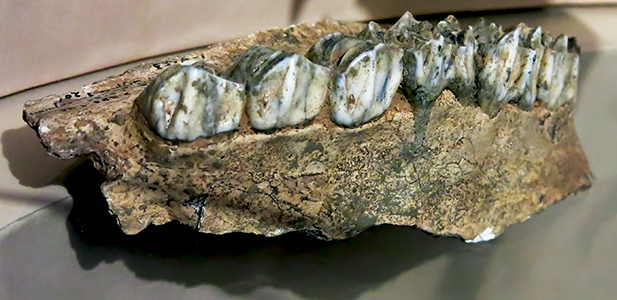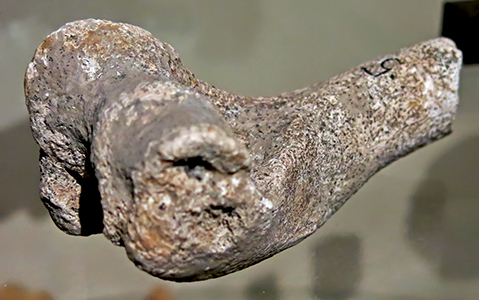Back to Don's Maps
Achenheim - a middle palaeolithic site on loess

The Achenheim site in the 1980s
Photo: Direction des Antiquités Préhistoriques d'Alsace
Rephotography: Don Hitchcock 2015
Source: Poster, Musée Archéologique Strasbourg
The Palaeolithic in Alsace
In Europe the climate of the last great geological era, the Quaternary, alternated between the cold period of the glaciations and the interglacials, periods when the climate warmed up. The evolution of fauna and vegetation was directly linked to the climate. This is the period of the great mammals of the Quaternary, whether in its warm or cold phases: mammoths, elephants, rhinoceros and the large carnivores.Text above: Poster, Musée Archéologique Strasbourg
This is also the period when the rich loess terrain of Alsace was formed. In a cold dry climate, these alluvial particles are carried by the wind, sometimes over enormous distances, and deposited in sheltered zones. During the interglacial phases the climate becomes warm and damp, the calcium salts in the loess dissolve, at the same time as iron salts are liberated. These migrate and help to form reddish brown layers of loam, alternating with the layers of loess.
There are few traces of the Palaeolithic in Alsace. There are practically no caves in the region, and any open-air sites are buried deeply in layers of loess. While there is little to be found in the way of dwelling sites and implements, the quarries excavated in the region have brought to light numerous remains of the larger fauna of the Quaternary. As well as these, traces of human activity going back 600 000 years have been found at Achenheim, in the form of archaic pebble tool industries.
A Major Reference: Achenheim
The Achenheim and Hangenbieten sites, 10 km to the west of Strasbourg, were discovered at the end of the 19th century when the loess beds were being used for brick making. The work of E. Schumacher and in particular Paul Wernert has established these sites as a major reference for the study of the Palaeolithic in Europe.Text above: Poster, Musée Archéologique Strasbourg
It has become customary, in the light of this work, to divide the Achenheim loess layers into four periods. They rest on alluvial deposits, divided into red Vosges sands and grey Rhine sands and pebbles. Valuable information on the evolution of the climate and the vegetation has been obtained from the study of these successive layers, which reach a depth of 20 or 30 metres. With the help of discoveries of animal bone remains and flaked stone tools, the evolution of Quaternary fauna and human industry in Alsace has been traced over several hundred thousand years.
( Note that the Bruche River which rises in the Vosges mountains may be the source of what is labelled above as 'red Vosges sands'. The modern 'Canal de la Bruche' passes through Achenheim, which may follow the former course of the Bruche - Don )
A hunting camp from the Middle Palaeolithic
An important site from the Middle Palaeolithic (75 000 to 35 000 years ago) bears witness to the presence of Neanderthal man in Alsace: an animal butchering area in Achenheim.
In Achenheim, a large Middle Paleolithic butchering area, Sol 74, was excavated in 1974 over an area of more than 200 m2. The distribution of fauna and stone tools forms areas of concentration with, in the central zone, the bones of several large animals including rhinoceroses and foxes.
The distribution of fauna and stone tools forms areas of concentration with, in the central zone, the bones of several large animals (rhinoceros, horse, mammoth, bison, Megaloceros) butchered on the spot after the hunt.
The siliceous stone tools, which are of a very archaic character, are of great variety and are concentrated mainly in the southern zone with chopping tools and sharp-edged scrapers for cutting the sinews and flesh of the slaughtered animals.
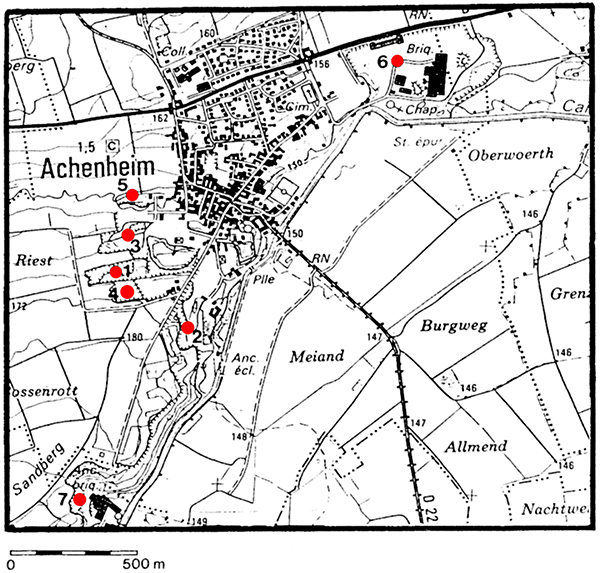
Fig.1 - Achenheim. Loessières à Achenheim et aux environs (d'après la carte topographique. Feuille 3816, Ouest,
1/25 000).
1 Sundhauser ouest
2 Sundhauser Est et Canal
3 Hurst
4 Schneider-Schaeffer
5 Gold
6 Materiaux de Construction S. A.
7 Jeuch-Wellau.
Map and text: Jürgen (1995)
Achenheim stratigraphy.
( The red vosgian alluvial sands possibly are associated with deposits from an earlier melting of the nearby Vosgian glacier, at the end of the Riss glaciation, circa 130 000 BP. Note also that the Bruche River which rises in the Vosges mountains may be the source of what is labelled above as 'red vosgian alluvial sands'. The modern 'Canal de la Bruche' passes through Achenheim, which may follow the former course of the Bruche.
The Eemian or Riss-Würm was the interglacial period which began about 130 000 BP after the end of the Riss and ended about 115 000 BP years ago at the beginning of the Last Glacial Period, the Würm.
The loess at this site was deposited by the action of wind on outwash plains of the Würm glaciation - Don )
Artist: After Paul Wernert
Rephotography and translation: Don Hitchcock 2015
Source: Poster, Musée Archéologique Strasbourg

Paul Wernert, who was responsible for most of the research on the Achenheim site.
Photo: Direction des Antiquités Préhistoriques d'Alsace
Rephotography: Don Hitchcock 2015
Source: Poster, Musée Archéologique Strasbourg
The Achenheim Loessiere in the 1980s: soil samples were taken for sedimentological analysis.
Photo: Direction des Antiquités Préhistoriques d'Alsace
Rephotography: Don Hitchcock 2015
Source: Poster, Musée Archéologique Strasbourg
The Achenheim Loessiere in the 1980s: close ups of the layers.
Photo: Direction des Antiquités Préhistoriques d'Alsace
Rephotography: Don Hitchcock 2015
Source: Poster, Musée Archéologique Strasbourg
Achenheim map and general view.
Artist: After Paul Wernert
Rephotography: Don Hitchcock 2015
Source: Poster, Musée Archéologique Strasbourg
Primary material and types of tool found at Achenheim.
Table and text: Jürgen (1995)
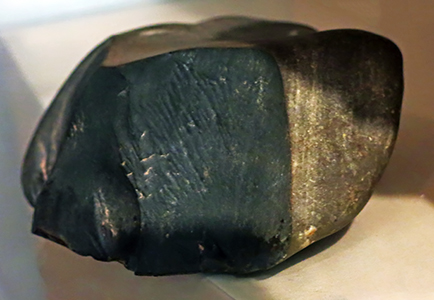
Achenheim, from the red silt of the plateau, Early Palaeolithic.
( i.e. from the red vosgian alluvial sands shown in the diagram above of the stratigraphy - Don )
Chopper on a thick pebble.
Photo: Don Hitchcock 2015
Source: Musée Archéologique Strasbourg
Achenheim, from the red silt of the plateau, Early Palaeolithic.
( i.e. from the red vosgian alluvial sands shown in the diagram above of the stratigraphy - Don )
Chopping tool: it has two removals on each side of the pebble.
Date of discovery: 30.6.1947
Photo: Don Hitchcock 2015
Source: Musée Archéologique Strasbourg
1.
Chopper from Waltenheim-sur-Zorn, Bas-Rhin, period of Homo erectus, donated by M. Ehretsmann.
Found in 1989.
( Readers should note that this artefact was found at or near the surface, not in situ. It had apparently been brought to the surface by ploughing - Don )
Quartzite, height 74 mm, width 52 mm, thickness 43 mm.
Its distal part has three successive groups
of removal:
A. Two primary removals (No. 1 and 2) created a free edge inclined at approximately 55°.
B. Two secondary removals (no. 3 and 4) resulting either from the shaping of the piece or from its use.
the present inclination of the cutting edge, i.e. close to 90° in relation to the edge of the pebble.
C. The keels (no. 5) are located on the side of the main edge of the tool, and are used to create a sharp edge.
This tool corresponds to the unidirectional cutter of Biberson's classification (1961) (type 12
of Ramendo (1963) ).
2.
Chopper from Achenheim with single removal in quartzite or quartzite sandstone. Found in: Rhine grey sands.
Photo: Don Hitchcock 2015
Source: Original, Musée Archéologique Strasbourg
Text: Ehretsmann (1991)

Achenheim, grey sands from the Rhine, Early Palaeolithic.
Chopper from a pebble with two removals. This is the oldest prehistoric tool discovered in Alsace.
( Since it was found in the grey sands of the Rhine, it thus predates the loess borne by the wind from glaciation, and therefore predates the last glaciation, see the stratigraphic section below - Don )
Early Palaeolithic, collection P. Wernert.
Photo: Don Hitchcock 2015
Source and text: Original, Musée Archéologique Strasbourg
Choppers and a chopping tool from Achenheim, loessière Hurst ( a loess rise? - Don )
At the site of Achenheim (Bas-Rhin, Alsace, France) near Strasbourg, thick loess deposits are found fossilising a former terrace of the Rhine and Bruche rivers which have been affected by neotectonics (recent earth movements).
The four loess deposits comprise a continual sedimentary sequence which spans the Late Pleistocene and a part of the Middle Pleistocene. Achenheim has a typical profile which can be correlated with the loess stratigraphy of Western and Central Europe.
Italicised text above: Heim (1982)
Photo: Don Hitchcock 2015
Source and text: Original, Musée Archéologique Strasbourg
Fauna found at Achenheim.
Table and text: Jürgen (1995)
Achenheim, Louessières Sundhauser et Hurst, red sands.
Skeleton of a ground or steppe squirrel.
Photo: Don Hitchcock 2015
Source: Musée Archéologique Strasbourg

Achenheim, lower ancient loess, Early Palaeolithic.
Uniface, on large greywacke flake. Traces of use on the sharp edges indicate that the tool was used for cutting.
Photo: Don Hitchcock 2015
Source: Musée Archéologique Strasbourg
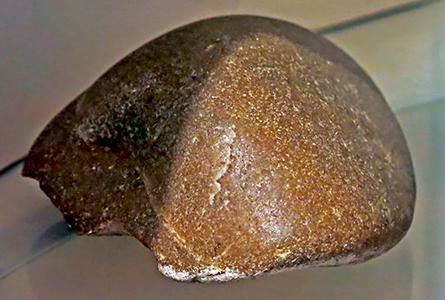
Achenheim, lower ancient loess, Early Palaeolithic.
Chopper with double removal.
Photo: Don Hitchcock 2015
Source: Musée Archéologique Strasbourg

Achenheim, lower ancient loess, Early Palaeolithic.
Shaped pebble.
Photo: Don Hitchcock 2015
Source: Musée Archéologique Strasbourg
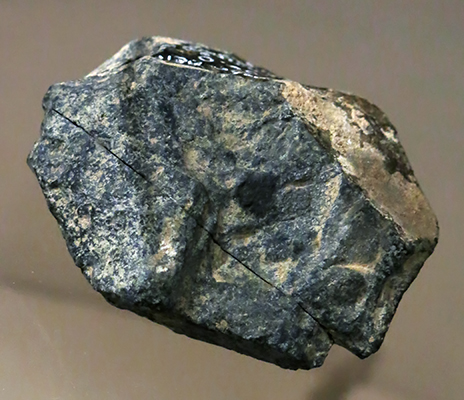
Achenheim, lower ancient loess, Early Palaeolithic.
Dihedral tool.
Photo: Don Hitchcock 2015
Source: Musée Archéologique Strasbourg
Achenheim, lower ancient loess, Early Palaeolithic.
Pebbles bearing signs of use.
Photo: Don Hitchcock 2015
Source: Musée Archéologique Strasbourg
Achenheim, Louessières Sundhauser et Hurst, lower ancient loess, Early Palaeolithic.
(top) Merck's Rhinoceros jaw.
(bottom) Molar of elephant
( possibly the straight-tusked elephant ( Palaeoloxodon antiquus ) - Don )
Photo: Don Hitchcock 2015
Source: Musée Archéologique Strasbourg
Achenheim, lower ancient loess, clay, Early Palaeolithic.
The edible snail Helix pomatia, also known as the Roman snail, Burgundy snail, or escargot.
Photo: Don Hitchcock 2015
Source: Musée Archéologique Strasbourg
Additional text: Wikipedia
Achenheim, lower ancient loess, clay, Early Palaeolithic.
Molar of the steppe mammoth Mammuthus trogontherii (?)
( The steppe mammoth evolved in Siberia during the Early Pleistocene from Mammuthus meridionalis, and was the ancestor of the woolly mammoth. Populations of the steppe mammoth may have persisted in northern China and Mongolia as late as 33 000 BP - Don )
Photo: Don Hitchcock 2015
Source: Musée Archéologique Strasbourg
Additional text: Wikipedia
Achenheim, lower ancient loess, clay, Early Palaeolithic.
Mandible of a deer.
Photo: Don Hitchcock 2015
Source: Musée Archéologique Strasbourg
Additional text: Wikipedia
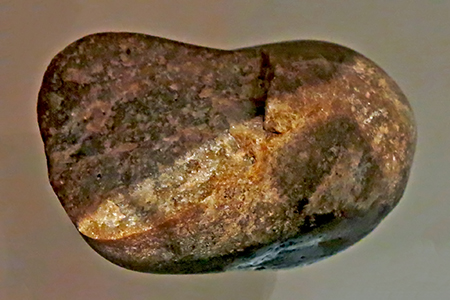
Achenheim, from the middle ancient loess, Early Palaeolithic.
Chopper with sinuous cutting edge.
Photo: Don Hitchcock 2015
Source: Musée Archéologique Strasbourg
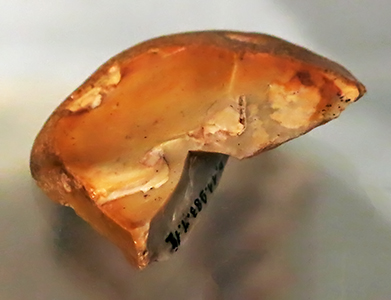
Achenheim, from the middle ancient loess, Early Palaeolithic.
Partial scraper on a flake.
Photo: Don Hitchcock 2015
Source: Musée Archéologique Strasbourg
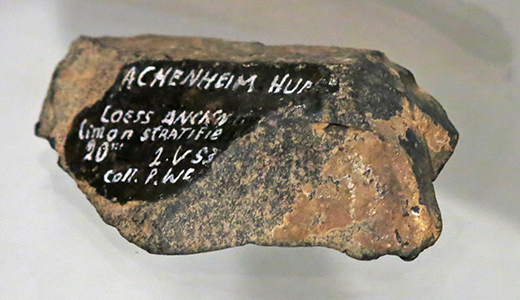
Achenheim, from the middle ancient loess, Early Palaeolithic.
Elongated flake.
Photo: Don Hitchcock 2015
Source: Musée Archéologique Strasbourg
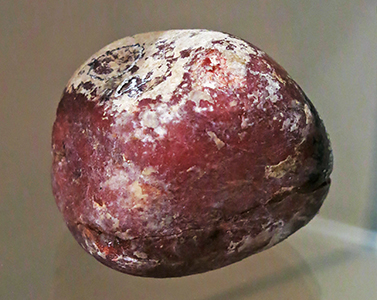
Achenheim, from the middle ancient loess, Early Palaeolithic.
Cubical pebble.
Photo: Don Hitchcock 2015
Source: Musée Archéologique Strasbourg
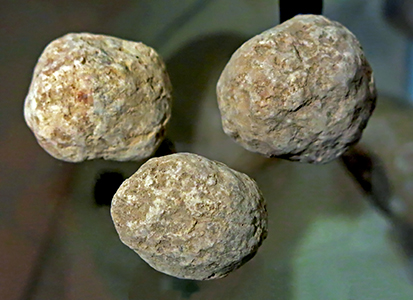
Achenheim, from the middle ancient loess, Early Palaeolithic.
Man-made loess balls. Their true use remains difficult to determine.
( These loess balls were almost certainly for roasting game in an underground pit, as Australian First Nations used. See below - Don )
Photo: Don Hitchcock 2015
Source: Musée Archéologique Strasbourg
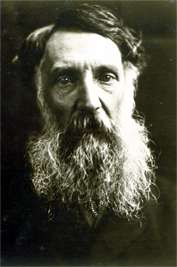
An eyewitness account
The following extract is an observation of an Australian Aboriginal oven hearth being made in the last century.
'The native oven is made by digging a circular hole in the ground, of a size corresponding to the quantity of food to be cooked. It is then lined with stones in the bottom (or clay balls where stones are unavailable), and a strong fire made over them so as to heat them thoroughly, and dry the hole. As soon as the stones are judged to be sufficiently hot, the fire is removed, and a few of the stones taken, and put inside the animal to be roasted if it be a large one. A few leaves or a handful of grass, are then sprinkled over the stones in the bottom of the oven, on which the animal is deposited, generally whole, with hot stones... laid on top of it. It is covered with grass, or leaves, and then thickly coated over with earth, which effectually prevents the heat from escaping.'
Edward John Eyre, 1845.
Photo: The Australian National Portrait Gallery, http://www.portrait.gov.au/
On my 2009 trip to Lake Mungo in the south of New South Wales I found more than a dozen hearths on the eastern side of the former lake. The First Nations people from 40 000 BP who lived there used to put stones or clay balls (stone was very hard to get, twenty kilometres away on the other side of the lake) in the bottom of a pit, get a decent fire going, then take out the coals, line it with grass and leaves, put a few of the stones inside the bird or animal, put hot stones on top of it, more grass and leaves, then cover with more earth or clay, wait several hours, then dig it up and have dinner.
This photo is of a hearth about 50 cm across which has used the clay balls. I found others where they used poor quality stones, possibly from the lake edge, as the lining of the hearth. They may also have brought dilly bags of poor stones from the other side of the lake just for hearths. The clay from termite mounds was also used.
Photo and text: Don Hitchcock 2009
Achenheim, from the middle ancient loess, Early Palaeolithic.
Bone tool, probably used as a 'compresseur' for flint knapping.
( Compresseurs were used for doing delicate retouch on a flint tool - Don )
Photo: Don Hitchcock 2015
Source: Musée Archéologique Strasbourg
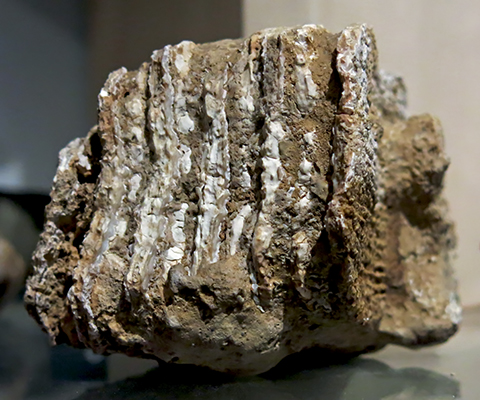
Achenheim, Louessières Sundhauser et Hurst, middle ancient loess.
Molar of mammoth.
Photo: Don Hitchcock 2015
Source: Musée Archéologique Strasbourg

Achenheim, Louessières Sundhauser et Hurst, middle ancient loess.
Hyena mandible.
Photo: Don Hitchcock 2015
Source: Musée Archéologique Strasbourg
Achenheim, Louessières Sundhauser et Hurst, middle ancient loess.
Deer mandible.
Photo: Don Hitchcock 2015
Source: Musée Archéologique Strasbourg
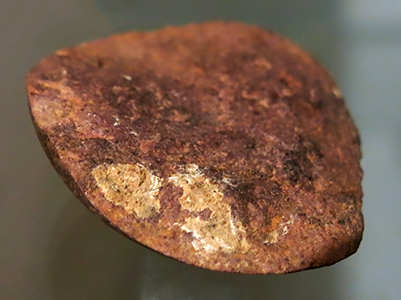
Achenheim, from the upper ancient loess, Middle Palaeolithic.
Quartzite flake with retouching (a backed knife?).
Photo: Don Hitchcock 2015
Source: Musée Archéologique Strasbourg
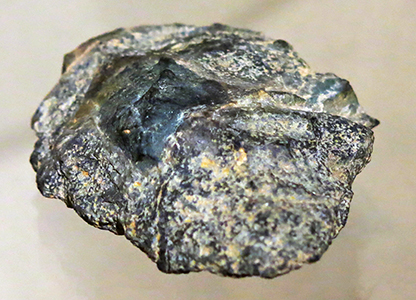
Achenheim, from the upper ancient loess/red clay, Middle Palaeolithic.
Cordiform (heart shaped) biface.
Photo: Don Hitchcock 2015
Source: Musée Archéologique Strasbourg
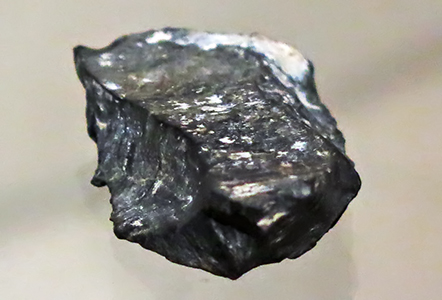
Achenheim, from the upper ancient loess/red clay, Middle Palaeolithic.
Flake.
Photo: Don Hitchcock 2015
Source: Musée Archéologique Strasbourg
Achenheim, Louessières Sundhauser et Hurst, upper ancient loess.
Molar of the European wild ass, Equus asinus hydruntinus, and a fragment of the jaw of a reindeer, Rangifer tarandus.
Photo: Don Hitchcock 2015
Source: Musée Archéologique Strasbourg
Achenheim, Louessières Sundhauser et Hurst, upper ancient loess.
Hyena humerus.
Photo: Don Hitchcock 2015
Source: Musée Archéologique Strasbourg
Achenheim, from the lower recent loess/red clay, Upper Palaeolithic.
Three-sided blade.
Photo: Don Hitchcock 2015
Source: Musée Archéologique Strasbourg
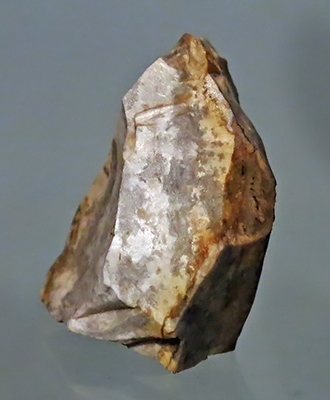
Achenheim, from the lower recent loess, Upper Palaeolithic.
Dihedral burin on a nucleus.
Photo: Don Hitchcock 2015
Source: Musée Archéologique Strasbourg
Achenheim, Louessières Sundhauser et Hurst, recent loess, Upper Palaeolithic.
Merck's Rhinoceros molar.
Photo: Don Hitchcock 2015
Source: Musée Archéologique Strasbourg

Achenheim, Louessières Sundhauser et Hurst, recent loess, Upper Palaeolithic.
Molar of a mammoth, Elephas primigenius.
Photo: Don Hitchcock 2015
Source: Musée Archéologique Strasbourg
References
- Ehretsmann M., 1991: Un chopper à Waltenheim-sur-Zorn (Bas-Rhin), Cahiers alsaciens d'archéologie, d'art et d'histoire, ) 01 janvier 1991
- Heim J., et. al., 1982: Achenheim: une séquence-type des loess du Pléistocène moyen et supérieur, Quaternaire Année 1982 19-2-3 pp. 147-159
- Jürgen J., 1995: Les ensembles lithiques d'Achenheim d'après la collection de Paul Wernert, Bulletin de la Société préhistorique française, tome 92, n°1, 1995. pp. 26-36; doi : https://doi.org/10.3406/bspf.1995.9971 https://www.persee.fr/doc bspf_0249-7638_1995_num_92_1_9971

